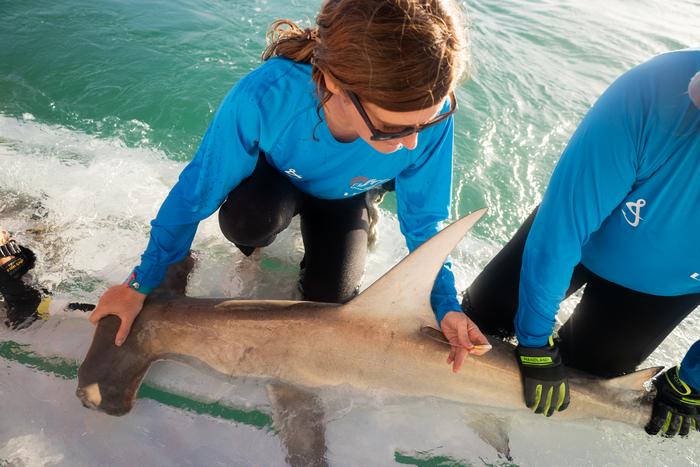A groundbreaking eight-year investigation led by researchers at the University of Miami’s Rosenstiel School of Marine, Atmospheric, and Earth Science unveils the critical role of Florida’s Biscayne Bay as an essential nursery and seasonal refuge for the critically endangered great hammerhead shark (Sphyrna mokarran). This extensive study sheds new light on how juvenile hammerheads depend on this unique coastal ecosystem during their formative stages and the ongoing importance of nearshore habitats throughout their life cycle. In an era marked by escalating environmental threats, the research underscores Biscayne Bay’s vital significance for the conservation of these apex predators.
Biscayne Bay, a sprawling shallow estuary intimately connected to the Miami metropolitan area, boasts an ecosystem rich in biodiversity and clear subtropical waters that foster a variety of marine life. However, anthropogenic pressures such as urban expansion, water pollution, reduced freshwater runoff, and habitat degradation have increasingly compromised the bay’s ecological integrity. This deterioration poses direct risks to species like the great hammerhead, whose survival hinges on delicate habitat conditions. This study’s revelations become pivotal in contextualizing how habitat quality influences endangered marine species’ developmental ecology and survival chances.
Utilizing an innovative approach combining multi-tissue stable isotope analysis, the research team meticulously tracked the dietary patterns and habitat utilization of 62 individual great hammerheads over the span from 2018 to 2025. This method allowed for detailed assessment of isotopic carbon and nitrogen ratios in various tissues, providing a temporal window into both recent and long-standing feeding behaviors. By examining muscle and blood plasma samples, scientists could discern shifts in resource use and habitat preferences as these sharks progressed through distinct ontogenetic stages, offering unprecedented resolution on their ecological dependencies.
The findings reveal that juvenile great hammerheads exhibit a strong, year-round reliance on the shallow inshore environments of Biscayne Bay. During the first two years—the most vulnerable period in their life cycle—these young sharks primarily inhabit and feed within the bay’s protected habitats. Their diet appears highly specialized early on, with a notable preference for small inshore stingrays, indicating a restricted trophic niche that may heighten their vulnerability to disturbances. Such dietary specialization emphasizes the critical need to preserve the prey base within these fragile estuarine zones.
As the sharks mature into subadulthood, a marked ontogenetic shift occurs. Older juveniles and subadults begin expanding their habitat use to include coral reefs and adjacent coastal waters, reflecting changing energetic demands and foraging strategies. However, the great hammerheads demonstrate seasonal fidelity to Biscayne Bay, migrating back to its productive waters from late spring through early summer. This cyclical movement suggests that the bay functions not only as a nursery but also as a critical seasonal refuge supporting diverse life stages.
Intriguingly, many adult great hammerheads continue to derive a portion of their dietary intake from Biscayne Bay resources, highlighting the bay’s ongoing ecological significance beyond juvenile development. This persistent interaction with nearshore habitats broadens the conservation imperative to safeguard these areas across the shark’s lifespan. The study’s detail enriches our understanding of the species’ complex life history and habitat connectivity, essential for designing effective marine protected areas and management strategies.
Despite Biscayne Bay’s biodiversity value, human-induced pressures threaten the stability of these ecosystems. The region’s booming recreational fishing industry presents particular risks, as great hammerheads are highly sensitive to capture stress and post-release mortality. The authors stress the urgent need for responsible fishing protocols, particularly during peak occupancy periods for juveniles and subadults, spanning March to July. Minimizing harmful interactions by advocating for rapid, in-water release procedures without delay-inducing activities like photography is vital for enhancing post-capture survival rates.
Underpinning the study is an advanced isotopic ecological framework. By integrating stable isotope signatures from multiple tissues with known tissue turnover rates, researchers inferred the temporal dynamics of feeding ecology and habitat association. Carbon isotope ratios helped distinguish between inshore and offshore dietary sources, while nitrogen isotopes illuminated trophic positioning. This comprehensive biochemical toolkit surmounts traditional limitations of direct observation, enabling non-lethal, fine-scale insights into the spatial and temporal resource use patterns of a highly elusive marine predator.
The implications of this research extend beyond Biscayne Bay, providing a template for conservation planning for great hammerheads throughout their range. By demonstrating the bay’s multi-faceted role—from nursery habitat to seasonal foraging ground—the study advocates for integrated habitat protection that acknowledges the species’ ontogenetic habitat shifts and the cumulative importance of coastal ecosystems. This aligns with broader conservation frameworks prioritizing ecosystem-based management and adaptive strategies in the context of climate change and human disturbances.
Funding from prestigious sources such as the National Geographic Society, Nature Trust of the Americas, Florida Sea Grant-Guy Harvey Fellowship, and University of Miami’s Mary Roche Fellowship attests to the scientific rigor and significance of the investigation. Published in the journal Ecology and Evolution on June 15, 2025, this research contributes a crucial dataset to the global scientific community, informing policy decisions and advancing marine ecology knowledge.
Ultimately, this intensive study elevates Biscayne Bay’s profile as a keystone habitat integral to the survival of the great hammerhead shark, one of the ocean’s most enigmatic and imperiled predators. Through advanced isotopic methodologies and longitudinal data collection, the research not only clarifies vital ecological linkages but also signals a call to action for preserving marine biodiversity amid mounting anthropogenic pressures. As the fight against species extinction intensifies, insights like these become indispensable tools for ensuring that future generations witness thriving great hammerhead populations within Florida’s coastal waters and beyond.
Subject of Research: Animals
Article Title: Nursery resource use dynamics in great hammerheads (Sphyrna mokarran) across ontogeny
News Publication Date: 16-Jun-2025
References:
Hlavin, J.F., & Macdonald, C.C. (2025). Nursery resource use dynamics in great hammerheads (Sphyrna mokarran) across ontogeny. Ecology and Evolution. DOI: 10.1002/ece3.71473
Image Credits: University of Miami Shark Research and Conservation Program
Keywords: Marine fishes, Endangered species, Conservation ecology, Conservation policies, Wildlife management




